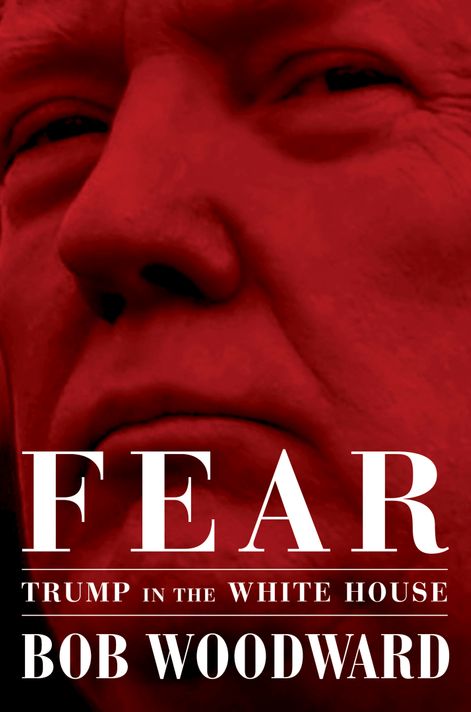Woodward’s ‘Fear’: A Splash, Then Silence
By • September 25, 2018 0 703

Star journalist and Georgetown resident Bob Woodward’s “Fear,” the ominously titled account of Donald Trump’s election and presidency (so far) was published on Sept. 11.
It immediately acquired notoriety — what with the ‘idiot’ quotes and descriptions of the chaotic conditions in the Trump White House, the comings and goings of personnel and staff (of which there were many), the president’s often virulent and short-attention-span meetings.
Overall, the book is a horrific, even shocking portrait of seat-of-the-pants, spur-of-the-moment decision-making on immigration, budget matters, tariffs, relationships with world leaders and, above all, the politics of policy, both domestic and international.
The book contains a cast of characters worthy of a major motion picture: Ivanka, son-in-law Jared, other family members, the chief of staff (a still combative Marine general), the secretary of defense, youthful Staff Secretary Rob Porter, National Economic Council Chair Gary Cohn, embattled Secretary of State Rex Tillerson and, until his downfall, the highly influential wild-card adviser Steve Bannon, rumpled and raunchy.
When it came out, the book — most of it sourced on deep background, as has been common with Woodward books — was met mostly with praise and with some scathing criticism from the White House, including a chorus of denials from the generals and other aides and high-ranking figures, notably attorneys for the president.
All presidential comments aside, Woodward is generally trusted about the facts and has a serious reputation for checking everything, including sources, backwards and forwards.
Not only that, but almost accompanying the book, though not directly connected to it, was the publication of an anonymous editorial in the New York Times, announcing itself as part of a resistance faction within the White House, dedicated to combating what it perceived as the administration’s more dangerous policies and actions.
The combination was explosive, and, one would think, would provide enough fodder for speculative editorializing and deep-think, deep-state posturing to last the rest of Trump’s term, or at least for a week or two.
So what happened? The book has sold 1.1 million copies, give or take, and rests at the top of the best-seller list, continuing Woodward’s history of success.
But the buzz has become strangely muted. While many people have obviously bought and read the book, especially in Washington, there’s very little talk about it anymore. It’s as if it made a big splash then faded away. And while there was talk of treason and a rash of initial speculation about the mysterious but still unidentified author or authors of the Times editorial, the subject has retreated into silence.
The book itself got its due respect and then some. It reads like, well, a Woodward book, a singular addition to a host of tomes including the history-making “All The President’s Men” and “The Final Days,” in which Woodward — with Carl Bernstein and with a little help from Deep Throat, Robert Redford and Dustin Hoffman — chronicled the fall of the Nixon administration, and perhaps even precipitated its collapse.
“Fear” begins with a pre-campaign account of a meeting of Trump men and ends with attorney John Dowd’s resignation, after a shocking and frustrating mock dry run with the president for a possible one-on-one session with former FBI head Robert Mueller, the special counsel investigating Russian meddling in the 2016 election.
The book is constructed for the most part of descriptions of a series of meetings in which aides, including Chief of Staff Rance Priebus, the defense secretary, Bannon, the intelligence establishment, generals and others take turns combating each other and trying to rein in or influence the president and his bent for constant attention, his use of Twitter and his forays into foreign policy.
While there are many new tidbits, they are more a part of an ongoing, always fluctuating picture of the administration and Trump, a fleshing out of a picture we have already seen.
Taken as a whole, the book should and ought to have a real impact — this is, to say the least, not a pretty picture. But today, two weeks after its publication, nobody talks about it over the coffee table or water cooler. Like other books, and other crises and firestorms — including real ones — “Fear,” the book, not the feeling, seems part of an indistinct, giant murmur that may yet rise again as a new explosion. But, then again, probably not.
We are, of course, in the midst of another s—storm, the hearings on Brett M. Kavanaugh’s nomination for a seat on the Supreme Court, which has been muddled and muddied by accusations of sexual misconduct from at least two, possibly three, women, dating back to his high school years at Georgetown Prep and his college years at Yale.
The controversy — or scandal, if you must — has consumed the Senate Judiciary Committee and the process of confirmation. It sits like a welt in the shadow of the upcoming midterm elections. It may turn into a he said-she said fiasco that will tear the country further apart along gender lines, as well as blue and red, left and right, Republican and Democrat. Already resonant of the Hill-Thomas battle of earlier times, the new developments, fluid as bourbon and just as mind-boggling, have consumed our table talk and pricked our feelings as men and women.
“Fear” has nothing to do with the Supreme Court contretemps, or whether or not Kavanaugh, who has flatly denied every accusation flung at him, should be on the court. It is rather a portrait of a president who feeds every flame of discord and discontent as if this controversy, like everything and everybody he comes in contact with, is as always about him.

